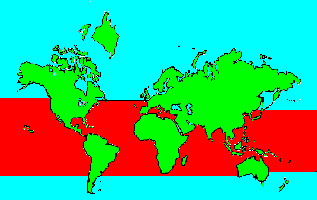SPECIES INFO
Big eye thresher (Alopias superciliosus) is found in the warmer oceans of the world. Schwartz notes this species is found in the western Atlantic from New Jersey to Cuba. He notes this is abundant near Cape Hatteras in the spring. This shark can reach about 14 or 15 feet in length. The large eyes are positioned so the shark can see above. The top half of the forked tail is almost as long as the body. (Technically, the body extends into this upper portion, and it is the caudal fin which is long.) The lower portion is very short. The pectoral fins are long. The color is grey.The thresher shark family contains 3 species. This family is found in all oceans of the world. This family can be recognized by the much elongated upper portion of the curved sickle shaped apparent tail typically as long as the main body of the shark. (Technically, the last part of the body is long and narrow, and it is the caudal fin that is about as long as half of the total length.) These sharks can reach from 12 to 20 feet in length. Because these sharks are hunted for their fins, their numbers are no doubt declining rapidly.
True Shark group (Order Lamniformes) used to contain the majority of the world's species of living sharks. They were characterized by having five gill slits. Some taxonomists recognized over fifteen families in this order. However, this order has been recently divided and several families that were previously here have been moved to the ground shark order (Carchariniformes). Other families have been moved to other orders.
The Reader's Digest book on sharks has several maps showing the relative frequency of shark attacks. Naturally, in areas where there is a lot of swimming and diving you would expect a greater number of attacks. In Australia the area near Sidney and Newcastle are subject to numerous attacks. The southern coast of Papua New Guinea is also dangerous. The area near Durban, South Africa is also dangerous. In North America areas near Savanah, Georgia and Miami are also risky. Cuba is also dangerous.
Sharks and rays (Elasmobranchi), cartilaginous fishes, deserve to be a class separate from the normal fish, in that they do not have a bone skeleton but rather a cartilage skeleton.
Fertilization is internal in this class which also separates them from the bony fish class. Although there are a few fresh water species, the majority of the species in this class are found in salt water. As of 2005, there were about 500 known species of sharks and about 600 known species of rays.
David Ebert, author of a recent book on sharks, rays, and chimaeras of California, counts a total of 988 described species in the class with about 150 additional species awaiting scientific description. He breaks down the described species to 410 species of sharks, 543 species of rays, and 35 species of chimaeras.
Many species of sharks face an uncertain future, as the Chinese purchase shark fins to make shark fin soup. It was estimated that 100 milllion sharks are killed each year for this purpose. However, recent estimates indicate the Chinese are reducing their consumption of this exotic soup.
Backboned Animals (Phylum Chordata) are the most advanced group of animals on earth. These animals are characterized by having a spinal cord or backbone. Most members have a clearly defined brain that controls the organism through a spinal cord. Fish, amphibians, reptiles, birds, and mammals are in this phylum.
Currently, some taxonomists believe that the fish should be divided into two groups (sharks and regular fishes) and that there are some other primitive groups in the phylum such as hagfish or lampreys.
Animal Kingdom contains numerous organisms that feed on other animals or plants. Included in the animal kingdom are the lower marine invertebrates such as sponges and corals, the jointed legged animals such as insects and spiders, and the backboned animals such as fish, amphibians, reptiles, birds, and mammals.

